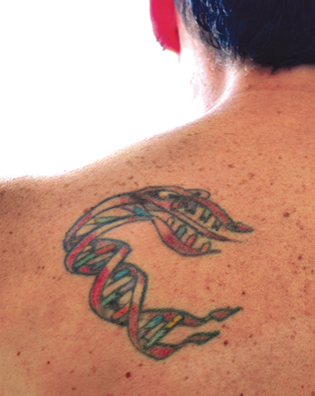 loading
loading
Arts & CultureObject lessonBody of work Carl Zimmer ’87 writes frequently for the New York Times and is the author of 12 books. He is a lecturer in Yale's Environmental Studies Program.  Jay Phelan ’87DNA is a popular image in the world of science tattoos. Jay Phelan ’87, a biologist, sports a dragon-like ladder of DNA representing the tension between genetics and human behavior. View full image
I have been writing about science for more than two decades, so I thought I understood scientists pretty well. But they can still surprise me. One day, when I was at a pool party, I spotted a neuroscientist in the water. On his shoulder was a tattoo of a twisting ladder of DNA. When I asked him about it, he explained that he’d encoded his wife’s initials in the molecule’s sequence of nucleotides. I wondered if this was a unique expression of geek love or if other scientists had tattoos as well, so I raised the question on my blog. Almost immediately, a physicist responded. “A former student got a tattoo of a cartoon atom on the back of one of his legs,” he recalled. As he was showing it off at rugby practice, another physics major walked by, looked at it and said, “Oh, please. The Bohr model?” before walking off. Soon after that the pictures started arriving. Scientists e-mailed me photographs of their arms, legs, flanks. It seemed that once they discovered I was curious about their body art, they couldn’t wait to send pictures of themselves in various states of disrobing. But I didn’t just want pictures; as a reporter, I wanted the backstory: when did they get their tattoos? Why? What is their significance? The tattoo pictured here is a typical example of what I received. It belongs to Jay Phelan ’87, who is now a biologist at UCLA and the author of several books. DNA is a fairly common image in the world of science tattoos, but Phelan’s is distinctive. Located on his back, it twists into a beast-like shape. He told me he got his tattoo in 1990 while in graduate school. “As I got deeper into the study of evolution, genetics, and human behavior, I realized that there was a tension between what my genes ‘wanted’ me to do and what I wanted to do—from the fattiness of the foods I ate, to the selfishness/selflessness I showed to others, to my risk-taking, and my relationships,” he explained. “I tried to come up with a design that captured that tension.” My collection of tattoos reached the dozens, then the hundreds. I probably have more than a thousand by now. They sprawled the sciences: linguistics, oceanography, paleontology, mathematics, geology, ecology. Some tattoos celebrated history—Darwin’s sketch of the tree of life, the seismograph of the 1906 San Francisco earthquake, a Vesalius engraving of an open brain. In 2011 I collected my favorite tattoos into a book entitled Science Ink. While working on it, I wondered about why this subculture does what it does. For some, tattoos are a kind of dermal pedagogy. A scientist walks down the beach with a constellation of stars on his back, people ask, and astronomy is explained. But it’s more than that. This body art is also a tribal marking: it displays membership in a branch of science, but also in the universe itself.
The comment period has expired.
|
|